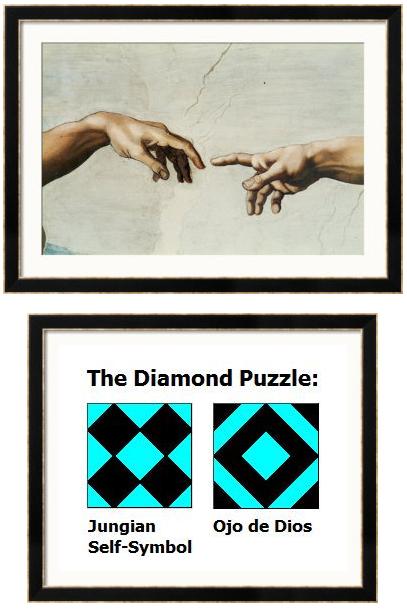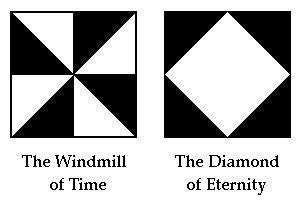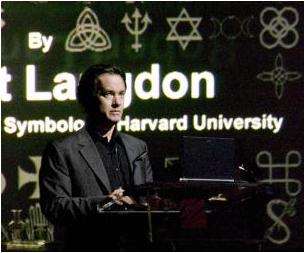Today's AP history notes …

The above image suggests a search for Missing Art.
For a black widow —
See history in today's Boston.com
and Waldorf in this journal.
"History instructs. History also has
a very dark sense of humor.
Irish history, especially."
— John Kelly in The Daily Beast this morning
See also Joyce's Nightmare and
Nightmare Alley in this journal.
Welcome to Westview continues.
My Windows lockscreen this morning features a badger
emerging from his den. Microsoft’s commentary —

Related commentary from Bellevue —
“History, Stephen said, is a nightmare
from which I am trying to awake.”
— James Joyce, Ulysses
The previous post, "Tesserae for a Tesseract," contains the following
passage from a 1987 review of a book about Finnegans Wake —
"Basically, Mr. Bishop sees the text from above
and as a whole — less as a sequential story than
as a box of pied type or tesserae for a mosaic,
materials for a pattern to be made."
A set of 16 of the Wechsler cubes below are tesserae that
may be used to make patterns in the Galois tesseract.
Another Bellevue story —
“History, Stephen said, is a nightmare
from which I am trying to awake.”
— James Joyce, Ulysses
Last evening's NY Lottery numbers
985 and 3274, interpreted as the
numbers of Log24 posts, suggest
a look at Joyce's nightmare— history.
* The title refers both to a film and to
a Log24 post, Random Access Memory.
(A prequel to Galois Field of Dreams)
The opening of Descartes' Dream ,
by Philip J. Davis and Reuben Hersh—
"The modern world,
our world of triumphant rationality,
began on November 10, 1619,
with a revelation and a nightmare."
For a revelation, see Battlefield Geometry.
For a nightmare, see Joyce's Nightmare.
Some later work of Descartes—
From "What Descartes knew of mathematics in 1628,"
by David Rabouin, CNRS-Univ. Paris Diderot,
Historia Mathematica , Volume 37, Issue 3,
Contexts, emergence and issues of Cartesian geometry,
August 2010, pages 428–459 —

Fig. 5. How to represent the difference between white, blue, and red
according to Rule XII [from Descartes, 1701, p. 34].
The 4×4 array of Descartes appears also in the Battlefield Geometry posts.
For its relevance to Galois's field of dreams, see (for instance) block designs.
A new Wikipedia page was created on Oct. 9—
"This page was last modified on 9 October 2012 at 19:54."
This, and a long-running musical, suggest…
"Try to remember the kind of September…"
LIFE Magazine for September 6, 1954, provides
one view of the kind of September when I was
twelve years old. (Also that September, Mitt Romney
was seven. President Obama was born later.)

Top of Life Magazine cover, September 6, 1954
This suggests James Joyce's nightmare view of history.
For some other views of 1954, see selected posts in this journal
that mention that year.
See also IMDb on Grace Kelly that year, and a related theological
reflection from Holy Cross Day, 2002.
An excerpt from "Araby," a short story by James Joyce—
At nine o'clock I heard my uncle's latchkey in the hall door. I heard him talking to himself and heard the hallstand rocking when it had received the weight of his overcoat. I could interpret these signs. When he was midway through his dinner I asked him to give me the money to go to the bazaar. He had forgotten.
'The people are in bed and after their first sleep now,' he said.
I did not smile. My aunt said to him energetically:
'Can't you give him the money and let him go? You've kept him late enough as it is.'
My uncle said he was very sorry he had forgotten. He said he believed in the old saying: 'All work and no play makes Jack a dull boy.' He asked me where I was going and, when I told him a second time, he asked me did I know The Arab's Farewell to his Steed . When I left the kitchen he was about to recite the opening lines of the piece to my aunt.
For a rather viciously anti-Catholic commentary, see Wallace Gray's Notes.
Update of 9:26 AM Oct. 22—
This is the same Wallace Gray who was an authority on Joyce at Columbia University and died on December 21, 2001. I prefer a different Columbia University Joyce scholar— William York Tindall (scroll down after clicking), who died on Sept. 8, 1981.
See also, from midnight a year after the date of Gray's death, Nightmare Alley.
Metaphor for Morphean morphosis,
Dreams that wake, transform, and die,
Calm and lucid this psychosis,
Joyce’s nightmare in Escher’s eye.

Related material:
Dialogue from Forbidden Planet —
Dialogue from another story —
“Sizewise?”
“Brainwise, but what they did was multiply me by myself into a quadratic.”
— Psychoshop, by Bester and Zelazny, 1998 paperback, p. 7
“… which would produce a special being– by means of that ‘cloned quadratic crap.’ [P. 75] The proper term sounds something like ‘Kaleideion‘….”
“So Adam is a Kaleideion?”
She shook her head.
“Not a Kaleideion. The Kaleideion….”
— Psychoshop, 1998 paperback, p. 85
|
“Kaleidoscope turning…
Shifting pattern within
|
“When life itself seems lunatic,
who knows where madness lies?”
— For the source, see
Joyce’s Nightmare Continues.
Joyce's Nightmare
continues
Today in History – March 2
|

|
From Gravity's Rainbow (Penguin Classics, 1995), page 563:
"He brings out the mandala he found.
Slothrop gives him the mandala. He hopes it will work like the mantra that Enzian told him once, mba-kayere (I am passed over), mba-kayere… a spell […]. A mezuzah. Safe passage through a bad night…."
In lieu of Slothrop's mandala, here is another…
Christ and the Four Elements
This 1495 image is found in
For further details,
click on any of the three mandalas above. |

Happy birthday to
Tom Wolfe, author of
The Painted Word.
— Today’s New York Times
review of the Very Rev.
Francis Bowes Sayre Jr.
Related material:
Log24 entries from
the anniversary this
year of Sayre’s birth
and from the date
of his death:
A link from the former
suggests the following
graphic meditation–

(Click on figure for details.)
A link from the latter
suggests another
graphic meditation–
(Click on figure for details.)
Although less specifically
American than the late
Reverend, who was
born in the White House,
hence perhaps irrelevant
to his political views,
these figures are not
without relevance to
his religion, which is
more about metanoia
than about paranoia.

From
“On the Holy Trinity,”
the entry in the 3:20 PM
French footprint:
“…while the scientist sees
everything that happens
in one point of space,
the poet feels
everything that happens
in one point of time…
all forming an
instantaneous and transparent
organism of events….”
From
“Angel in the Details,”
the entry in the 3:59 PM
French footprint:
“I dwell in Possibility –
A fairer House than Prose”
These, along with this afternoon’s
earlier entry, suggest a review
of a third Log24 item, Windmills,
with an actress from France as…
|
Changing Woman: “Kaleidoscope turning…
Shifting pattern |
“When life itself seems lunatic,
who knows where madness lies?”
— For the source, see
Joyce’s Nightmare Continues.
In all thy thousand images
we salute thee.
"Harish, who was of a
spiritual, even religious, cast
and who liked to express himself in
metaphors, vivid and compelling,
did see, I believe, mathematics
as mediating between man and
what one can only call God."
— R. P. Langlands
From a link of Jan. 17, 2008—
Time and Eternity:


Jean Simmons (l.) and Deborah Kerr (r.)
in "Black Narcissus" (1947)
and from the next day,
Jan. 18, 2008:
… Todo lo sé por el lucero puro
que brilla en la diadema de la Muerte.
— Rubén Darío,
born January 18, 1867
Related material:
Dark Lady and Bright Star,
Time and Eternity,
Damnation Morning
Happy birthday also to
the late John O'Hara.
Obituaries in the News
By THE ASSOCIATED PRESS
Filed at 6:13 a.m. ET
Norman Hackerman
“AUSTIN, Texas (AP) — Norman Hackerman, a chemist … died Saturday [June 16] …. He was 95. … He taught chemistry … before joining the Manhattan Project to develop a nuclear weapon during World War II.”
The date of Hackerman’s death is celebrated in Ireland as Bloomsday— the day on which, in 1904, the events of James Joyce’s novel Ulysses came to pass.
Scene from
“Behind the Lid” —

Photo by Richard Termine
Those who like such scenes may consult past Log24 entries. They will find, for instance, the following, commemorating a death which, like Hackerman’s, occurred on a Bloomsday:
Click on the picture for details.
“History, Stephen said,
is a nightmare
from which I am
trying to awake.”
— Ulysses

The next novel starring
Robert Langdon, Harvard author
of "the renowned collegiate
texbook Religious Iconology"
is said to be titled
The Solomon Key.
Related material–
The Harvard Crimson online:
| Fishburne To Receive Honors at Cultural Rhythms Acclaimed actor and humanitarian chosen as the Harvard Foundation's Artist of the Year By DORIS A. HERNANDEZ Friday, February 16, 2007 9:37 PM Tony and Emmy Award-winning actor Laurence Fishburne will take the stage later this month as the 2007 Artist of the Year during the 22nd annual Cultural Rhythms festival, the Harvard Foundation for Intercultural and Race Relations announced Friday afternoon. |

Fishburne
as Morpheus

"Metaphor for Morphean morphosis,
Dreams that wake, transform, and die,
Calm and lucid this psychosis,
Joyce's nightmare in Escher's eye….
Dabo claves regni caelorum. By silent shore
Ripples spread from castle rock. The metaphor
For metamorphosis no keys unlock."
— Steven H. Cullinane,
November 7, 1986,
"Endgame"
More on metamorphosis–
Cat's Yarn
(Log24, June 20, 2006):
"The end is where
we start from."



plus.maths.org
and
Garfield 2003-06-24
See also:
Zen Koan
and
Blue Dream.
Update of 5:24 PM
Feb. 18, 2007:
A Xanga footprint from France
this afternoon (3:47 PM EST)
indicates that someone there
may be interested in the above
poem's "claves regni caelorum."
The visitor from France viewed
"Windmills" (Nov. 15, 2005).
Material related to that entry
may be found in various places
at Log24.com. See particularly
"Shine On, Hermann Weyl," and
entries for Women's History
Month last year that include
"Christ at the Lapin Agile."
“Who knows where madness lies?”
— Rhetorical question
in “Man of La Mancha”
(See previous entry.)
Using madness to
seek out madness, let us
consult today’s numbers…
Pennsylvania Lottery
Nov. 22, 2006:
Mid-day 487
Evening 814
The number 487 leads us to
page 487 in the
May 1977 PMLA,
“The Form of Carnival
in Under the Volcano“:
“The printing presses’ flywheel
marks the whirl of time*
that will split La Despedida….”
From Dana Grove,
A Rhetorical Analysis of
Under the Volcano,
page 92:

“… a point of common understanding
between the classic and romantic worlds.
Quality, the cleavage term between
hip and square, seemed to be it.”
— Robert M. Pirsig

Rebecca Goldstein
The 8/14 entry also deals with
Rebecca Goldstein, who
seems to understand
such cleavage
very well.
(See also today’s previous entry.)
* Cf. Shakespeare’s “whirligig of time“
linked to in the previous entry.)
Ineluctable
On the poetry of Geoffrey Hill:
"… why read him? Because of the things he writes about—war and peace and sacrifice, and the search for meaning and the truths of the heart, and for that haunting sense that, in spite of war and terror and the indifferences that make up our daily hells, there really is some grander reality, some ineluctable presence we keep touching. There remains in Hill the daunting possibility that it may actually all cohere in the end, or at least enough of it to keep us searching for more.
There is a hard edge to Hill, a strong Calvinist streak in him, and an intelligence that reminds one of Milton….."
— Paul Mariani, review in America of Geoffrey Hill's The Orchards of Syon
"Hello! Kinch here. Put me on to Edenville. Aleph, alpha: nought, nought, one."
"A very short space of time through very short times of space…. Am I walking into eternity along Sandymount strand?"
— James Joyce, Ulysses, Proteus chapter
"Time has been unfolded into space."
"Pattern and symmetry are closely related."
— James O. Coplien on Symmetry Breaking
"… as the critic S. L. Goldberg puts it, 'the chapter explores the Protean transformations of matter in time . . . apprehensible only in the condition of flux . . . as object . . . and Stephen himself, as subject. In the one aspect Stephen is seeking the principles of change and the underlying substance of sensory experience; in the other, he is seeking his self among its temporal manifestations'….
— Goldberg, S.L. 'Homer and the Nightmare of History.' Modern Critical Views: James Joyce. Ed. Harold Bloom. New York: Chelsea House, 1986. 21-38."
— from the Choate site of David M. Loeb
 Joyce |
(By the way, Jorn Barger seems
to have emerged from seclusion.)
Nightmare Alley
Tonight’s site music in the garden of good and evil is “Hooray for Hollywood,” with lyrics by Johnny Mercer:
Hooray for Hollywood.
You may be homely in your neighborhood,
But if you think you can be an actor,
see Mr. Factor,
he’d make a monkey look good.
Within a half an hour,
you look like Tyrone Power!
Hooray for Hollywood!
From Pif magazine:
Nightmare Alley (1947)
Directed by Edmund Goulding
Reviewed by Nick Burton
“Edmund Goulding’s film of William Lindsay Gresham’s 1946 novel Nightmare Alley may just be the great forgotten American film; it is certainly the darkest film that came from the Hollywood studio system in the ’40s….
A never better Tyrone Power stars as Stan Carlisle, a small-time carny shill…. Stan shills for mind reader Zeena…. The… pretty ‘electric girl’… tells Stan that Zeena… had a ‘code’ for the mind-reading act… Stan… decides to seduce… Zeena in hopes of luring the code from her.”
The rest of this review is well worth reading, though less relevant to my present theme — that of my
which points out that the article on “nothing” is on page 265 of The Oxford Dictionary of Philosophy. (This is also the theme of yesterday’s journal entry “Last-Minute Shopping.”) Here is another work that prominently features “nothing” on page 265… As it happens, this is a web page describing a mind-reading act, titled simply
“Imagine this: A spectator is invited to take a readable and 100% examinable, 400 page, 160,000 word novel, open it to any page and think of any word on that page. Without touching the book or approaching the spectator, you reveal the word in the simplest, most startlingly direct manner ever! It truly must be seen to be believed.
The ultimate any-word-on-any-page method that makes all other book tests obsolete….
All pages are different.
Nothing is written down.
There are no stooges of any kind. Everything may be examined….
‘Throw away your Key. This is direct mindreading at its best.'”
|
From Finnegans Wake, page 265: “…the winnerful wonnerful wanders off, with hedges of ivy and |
Hooray.
Mercer’s lyrics are from the 1937 film
16 Years Ago Today:
Endgame

Metaphor for Morphean morphosis,
Dreams that wake, transform, and die,
Calm and lucid this psychosis,
Joyce’s nightmare in Escher’s eye.
At the end there is a city
With cathedral bright and sane
Facing inward from the pity
On the endgame’s wavy plane.
Black the knight upon that ocean,
Bright the sun upon the king.
Dark the queen that stands beside him,
White his castle, threatening.
In the shadows’ see a bishop
Guards his queen of love and hate.
Another move, the game will be up;
Take the queen, her knight will mate.
The knight said “Move, be done. It’s over.”
“Love and resign,” the bishop cried.
“When it’s done you’ll stand forever
By the darkest beauty’s side.”
Dabo claves regni caelorum. By silent shore
Ripples spread from castle rock. The metaphor
For metamorphosis no keys unlock.
— Steven H. Cullinane, November 7, 1986
Accompaniment from
“The Thomas Crown Affair”:
Michel Legrand, “Les Moulins de Mon Coeur”
Lyrics by Eddy Marnay:
Comme une pierre que l’on jette
Dans l’eau vive d’un ruisseau
Et qui laisse derrière elle
Des milliers de ronds dans l’eau….
"History is a nightmare
from which I am trying to awake"
— James Joyce in Ulysses
"Be of good cheer, Master Ridley, and play the man, for we shall this day light such a candle in England as I trust by God's grace shall never be put out."
— Hugh Latimer, former Bishop of Worcester, to his friend Nicholas Ridley, former private chaplain to Henry VIII, on the occasion of their being burned at the stake by the Roman Catholic queen Bloody Mary Tudor on October 16, 1555
Powered by WordPress